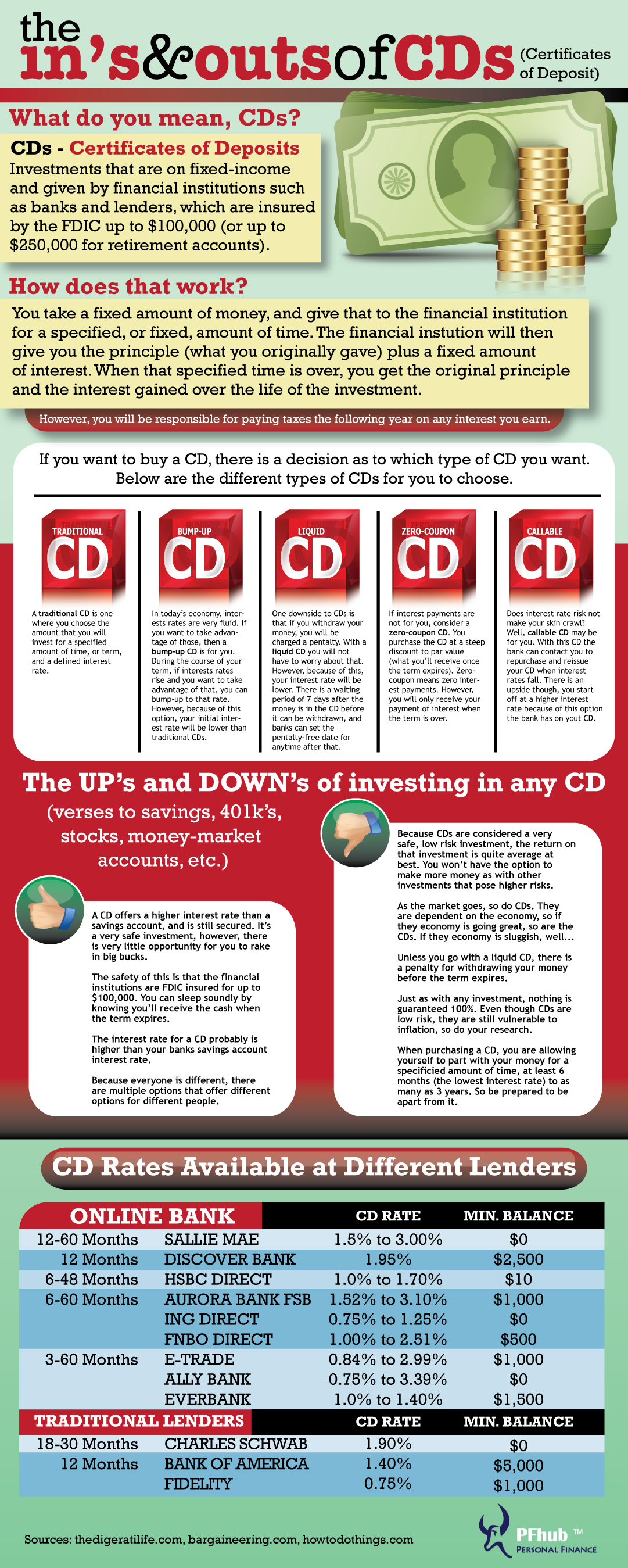This infographic about certificate of deposits (CDs) will teach you about the different types of CDs available. From a traditional CD to a callable CD find out which investment vehicle suits your needs the best.
At the bottom of this infographic you will see a list of banks and the different CD offers they have available.
Like This? Share It!
Click the Image Below to Make it Bigger

CDs – Certificates of Deposits
Investments that are on fixed-income and given by financial institutions such as banks and lenders, which are insured by the FDIC up to $100,000 (or up to $250,000 for retirement accounts).
How does that work?
You take a fixed amount of money, and give that to the financial institution for a specified, or fixed, amount of time. The financial instution will then give you the principle (what you originally gave) plus a fixed amount of interest. When that specified time is over, you get the original principle and the interest gained over the life of the investment.
However, you will be responsible for paying taxes the following year on any interest you earn.
Traditional CD
A traditional CD is one where you choose the amount that you will invest for a specified amount of time, or term, and a defined interest rate.
Bump-up CD
In today’s economy, interests rates are very fluid. If you want to take advantage of those, then a bump-up CD is for you. During the course of your term, if interests rates rise and you want to take advantage of that, you can bump-up to that rate. However, because of this option, your initial interest rate will be lower than traditional CDs.
Liquid CD
One downside to CDs is that if you withdraw your money, you will be charged a pentalty. With a liquid CD you will not have to worry about that. However, because of this, your interest rate will be lower. There is a waiting period of 7 days after the money is in the CD before it can be withdrawn, and banks can set the penalty-free date for anytime after that.
Zero-coupon CD
If interest payments are not for you, consider a zero-coupon CD. You purchase the CD at a steep discount to par value (what you’ll receive once the term expires). Zero coupon means zero interest payments. However, you will only receive your payment of interest when the term is over.
Callable CD
Does interest rate risk not make your skin crawl? Well, callable CD may be for you. With this CD the bank can contact you to repurchase and reissue your CD when interest rates fall. There is an upside though, you start off at a higher interest rate because of this option the bank has on yout CD.
The UP’s and DOWN’s of investing in any CD
verses to savings, 401k’s, stocks, money-market accounts, etc.
Ups: A CD offers a higher interest rate than a savings account, and is still secured. It’s a very safe investment, however, there is very little opportunity for you to rake in big bucks. The safety of this is that the financial institutions are FDIC insured for up to $100,000. You can sleep soundly by knowing you’ll receive the cash when the term expires.
The interest rate for a CD probably is higher than your banks savings account interest rate. Because everyone is different, there are multiple options that offer different
options for different people.
Downs: Because CDs are considered a very safe, low risk investment, the return on that investment is quite average at best. You won’t have the option to make more money as with other investments that pose higher risks.
As the market goes, so do CDs. They are dependent on the economy, so if they economy is going great, so are the CDs. If they economy is sluggish, well… Unless you go with a liquid CD, there is a penalty for withdrawing your money before the term expires.
Just as with any investment, nothing is guaranteed 100%. Even though CDs are low risk, they are still vulnerable to inflation, so do your research.
When purchasing a CD, you are allowing yourself to part with your money for a specific amount of time, at least 6 months (the lowest interest rate) to as many as 3 years. So be prepared to be apart from it.


